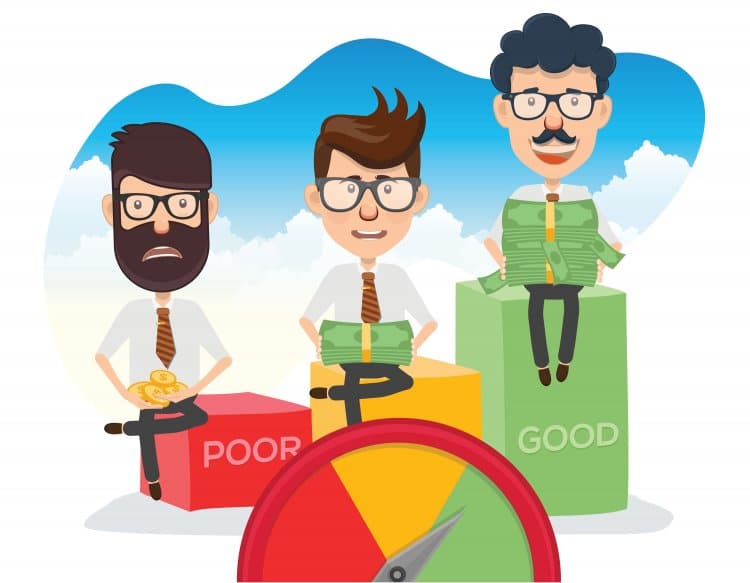Three main credit bureaus prepare the credit reports of American citizens, residents and workers. However, what we know as credit bureaus today actually began as small organizations in the 1700s. The modern-day credit bureau model represents an improvement on the old way of credit reporting, which included unethical ways of collecting and sharing people’s personal information. This contributed to the birth of the Fair Credit Reporting Act and consumer rights.
The Early Stages of the Credit Bureau History
The first known organization that collected and shared credit information about entities was English and chose a mouthful for a name: Society of Guardians for the Protection of Trade Against Swindlers and Sharpers. This and other groups mainly consisted of and served merchants who needed to calculate the borrowing-risk of consumers.
By 1960, roughly 1,500 such organizations existed within the United States. These organizations operated independently and did not share consumer information with each other. Unfortunately, these were the organizations that resorted to shady tactics to get people’s personal information.
At that time, credit reports included even your drinking habits and race. Most also only collected and reported negative information. To add to this, consumers had no access to the information collected, stored and shared about them.
The First Big Change
During the 1960s, many of the smaller organizations absorbed each other and grew. As the practices continued to grow out of hand, the federal government created the Fair Credit Reporting Act of 1971. The act finally extended protections to consumers, such as the following:
- Right to notification if derogatory information led to negative credit actions
- Right to determine consent for allowing employers to check credit
- Right to request removal from lists creditors use for unsolicited offers
- A seven-to-10-year time limit for reported information
- Access to the information contained in credit report files
- Right to dispute inaccuracies
The Modernization Period
The changes above led to a new approach to collecting and reporting credit information. Credit organizations now stopped recording particular events, such as arrests and marriages. Instead, they honed in on specific credit information. However, shady practices continued, so in 1996, the federal government modernized the act by making the following additions:
- Consumer right to legal action against anyone who receives unauthorized access to credit information
- Consumer right to hold credit bureaus legally responsible for deliberately reporting false or inaccurate information
- Consumer right to restrict banks from sharing information with affiliates
- Credit bureau responsibility to investigate disputes within 30 days or so
The Separate Histories of Four Credit Bureaus
The three main credit bureaus include Equifax, TransUnion and Experian. However, did you know there was a fourth?
Experian
The history of Experian begins in 1826 when the Manchester Guardian Society decided to collect and share information on high-risk borrowers. Later, Experian also absorbed merchants. The company became involved in shady practices in the 1990s and faced several lawsuits related to inaccurate reporting. This included a Vermont incident that ruined the credit of 1,400 residents. Experian has also had run-ins with the Federal Trade Commission and experienced a data breach in 2015.
Equifax
A grocery store owner started Equifax as Retail Credit Company in 1898. It started off by providing a list of customers who were low-risk borrowers. By the 1960s, it had information on millions of Americans. Before the FCRA, Equifax was one of the companies consumers despised for invasive and other unethical practices. Unfortunately, many people believe the company did not give up its old habits, which its handling of the 2017 breach did not resolve.
TransUnion
As the name might hint at, it started in 1968 as a transportation company. TransUnion moved into the credit bureau market by purchasing large credit reporting organizations in 1969. Like all the other major credit bureaus, TransUnion has faced accusations and lawsuits. In fact, the largest FCRA verdict record goes to TransUnion with a $60 million settlement. The company suffered its data breach in 2017 which led to malware infections.
Innovis
The fourth and mostly unknown credit bureau got its start in 1970 as Associated Credit Bureaus. Innovis earned its new name in 1997 and was acquired in 1999 by CBC Companies, Inc. Much less is known about Innovis. While it operates similarly to the other three credit bureaus, it does not have access to as much information as the others.
Discrimination in Credit Reporting
Despite the many consumer protections offered by the FCRA, several researchers continue to find and confirm that Hispanics and African Americans have lower credit scores than White Americans with the same demographic information. Coupled with the effects of other forms of socio-economic inequality, it might take some time for these biases to fade out, if at all.
How We Can Help
At Coast Tradelines, we provide equal access to the opportunity to improve scores by purchasing tradelines. Whether you are an immigrant with a new credit history or an American-born citizen who has suffered several credit dings, tradelines might help. Fill out our assessment to get started.



